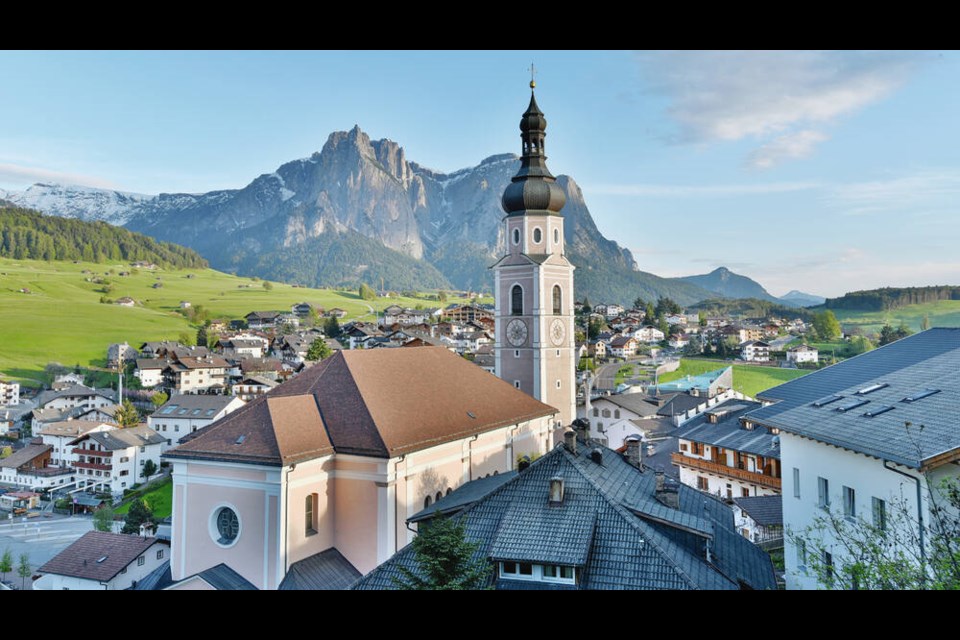The German-speaking Italian town of Castelrotto — called “Kastelruth” by its German-speaking residents — lies tucked away in the Dolomites, the Alps of northeastern Italy. It’s my favourite hideaway in “South Tirol,” a region of Italy that gives visitors a strong dash of Germanic culture.
Kastelruth is the ideal home base for exploring the Dolomites — Italy’s ski country in winter, and hiking wonderland in summer. Though this town was built for farmers, not vacationers, it has good bus connections, fine and friendly hotels, and more village character than any town around.
With its traffic-free centre, a thousand years of history, an oversized and hyperactive bell tower, and traditionally clad locals, it seems of another world.
During a trip through Italy, I enjoy a break from pizza and pasta. Wurst and sauerkraut are Tirolean clichés — more adventurous eaters seek out Speck, a raw, prosciutto-style ham smoked for five months, then thinly sliced and served as an antipasto or in sandwiches. Large dumplings — with bits of Speck, liver, spinach, or cheese — are often served in sauce, or with butter and cheese. (Never cut a dumpling with a knife. My friends here tell me, “It’ll destroy the chef.”) For dessert, strudel is everywhere, filled with the region’s renowned apples.
Tiny Kastelruth puts its central square to good use, with a busy farmers market on summer Fridays and a clothing and craft market on most Thursdays. If you’re on the square on a weekday afternoon, you may see local moms gathering their preschoolers, chatting, then heading en masse down the street to the playground. And before and after Sunday Mass, the square is crowded with villagers and farmers in their traditional clothing.
At 250 feet high, Kastelruth’s bell tower — the tallest in the region — dominates the town. When you feel the pride locals have in their tower, a symbol of their town, you’ll better understand why Italy is called “the land of a thousand bell towers.”
The bells of Kastelruth are a big part of the town experience, ringing on the hour from 6 a.m. to 10 p.m. While sleepy tourists wonder why they clang so early in the morning, locals — who grew up with the chimes — find them comforting.
The bells mark the hours, summon people to Mass, announce festivals, and warn when storms threaten. In the days when people used to believe that thunder was the devil approaching, the bells called everyone to pray. (Townspeople once thought the sound of the bells cleared the clouds.)
Another symbol of Kastelruth is its carved witches — folk figures that date back to when this area was the Salem of this corner of Europe. Women considered somehow threatening — including many midwives, healers, and redheads — were sometimes tried and burned as witches.
These days, the region is most famous for its contribution to the world of oompah music. The folk-singing group Kastelruther Spatzen — the ABBA of the Alps — is a gang of local boys who put Kastelruth on the map in the 1980s. They have a huge following here and throughout the German-speaking world.
The group’s feel-good folk-pop style — an alpine version of German Schlager music — is popular with the kind of conservative, working-class German speakers who like to vacation in South Tirol. In mid-October, the town is packed for Kastelruther Spatzenfest — when the band puts on a hometown concert.
One street over from the main square is the Kastelruther Spatzen shop, which includes a folksy little museum slathered with gifts, awards, and gold records.
To save a little money, I enjoy a picnic on the balcony of my room. The menu tonight: rough, bakery-fresh Austrian-style bread, salami, carrots, a tub of yogurt, and Apfelsaft (apple juice). I notice that everything’s in two languages here — my yogurt is both frutti di bosco and Waldfruchte … that’s “berries of the forest.” The fact that my feast cost less than 10 euros makes it taste even better.
With a happy soundtrack of German-speaking Italian children playing just out of sight, I watch a slow show as darkness settles on the Dolomites. Gradually the rugged limestone peaks that surround me become monotone, then gone.
This article is used with the permission of Rick Steves’ Europe. Rick Steves writes European guidebooks, hosts travel shows on public TV and radio, and organizes European tours.



